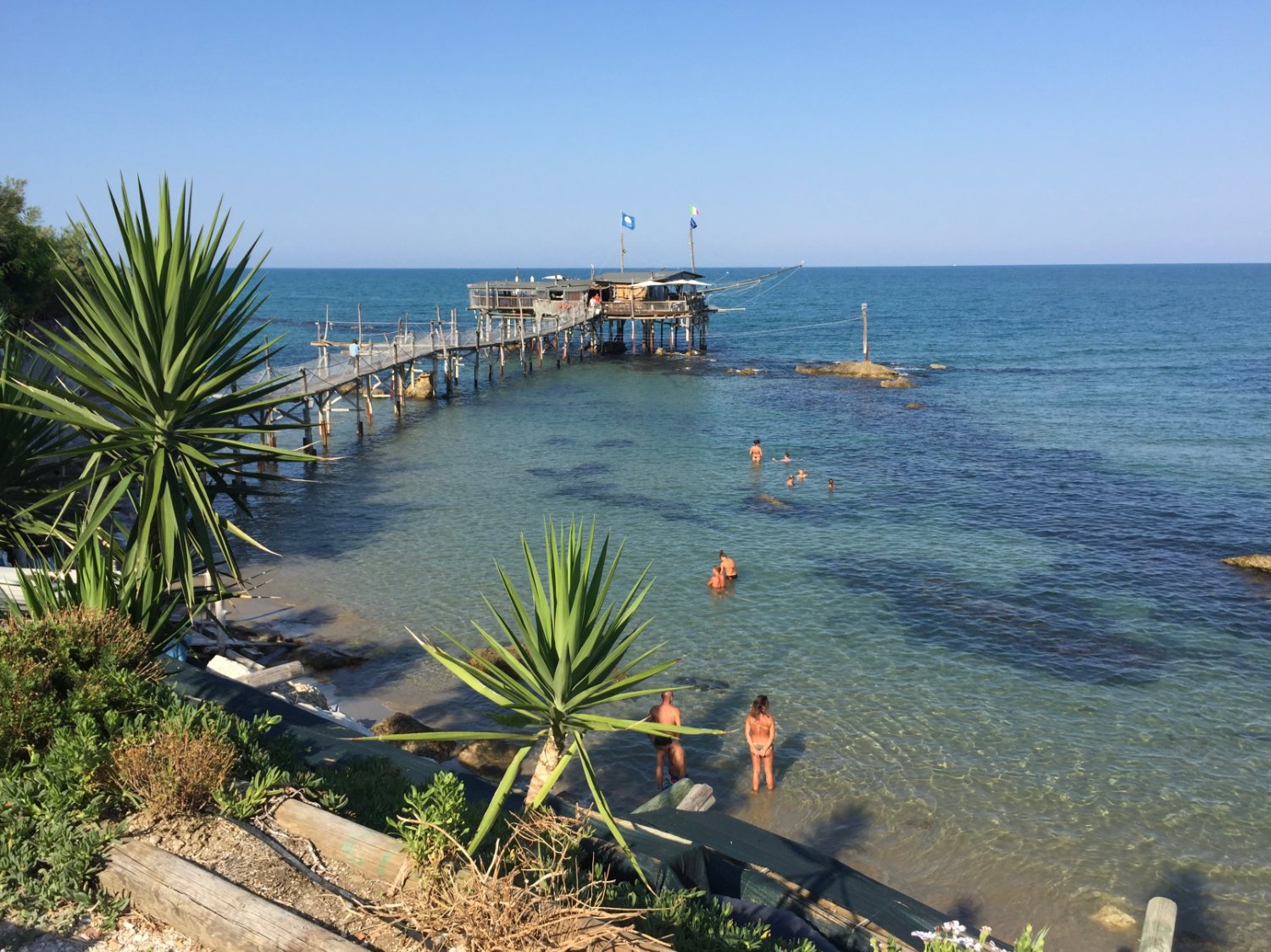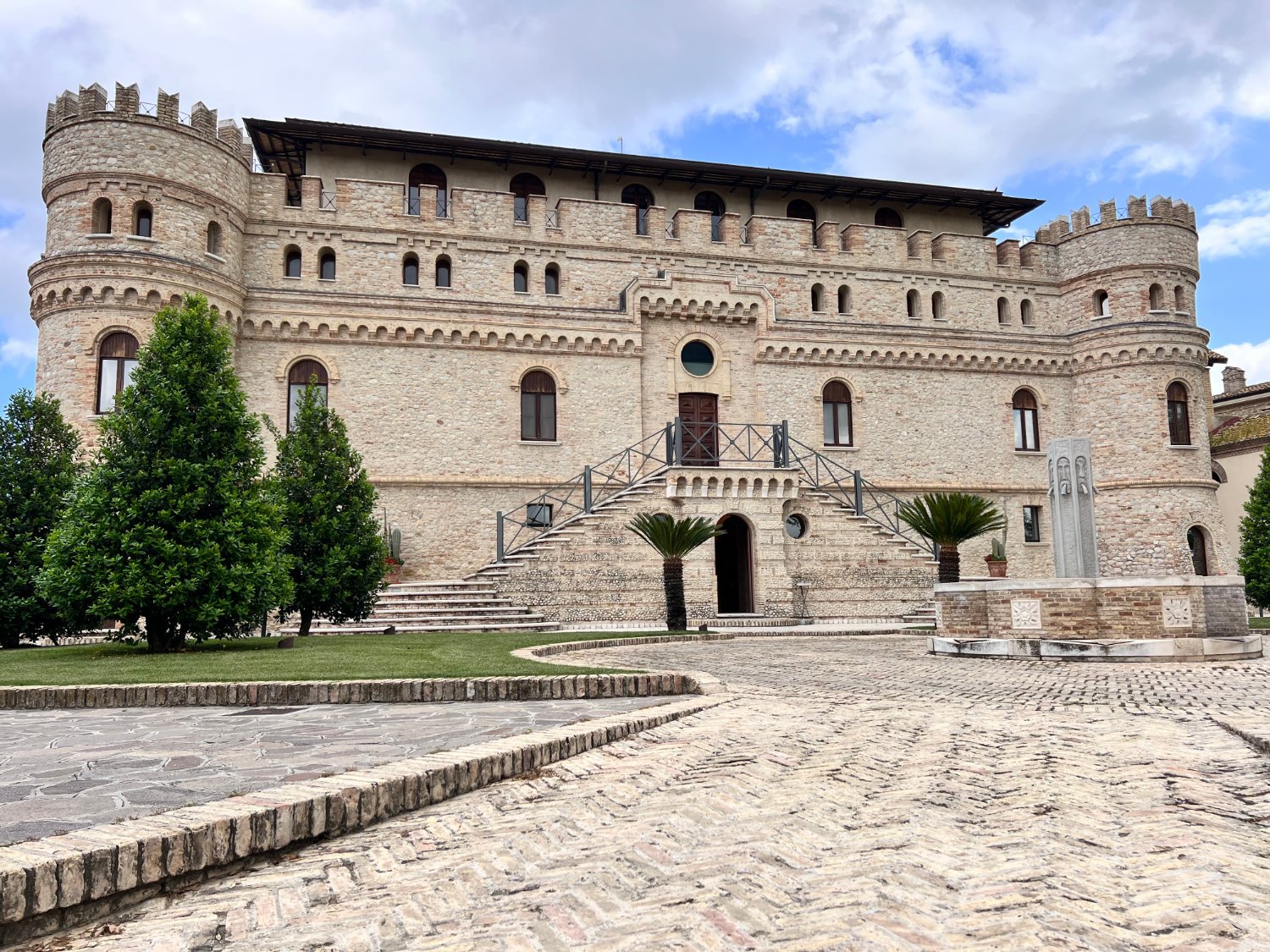71km Lanciano - Fossacesia
Castello Septe
Ride overview
Two miracles, an abbey, a cycle path beside the sea, and one of the best gravel tracks in Abruzzo combine to make this a fabulous day out. Leaving Lanciano, the route heads over hills and down dales to the Sangro valley, now a wide and peaceful place full of fields rich in vines and other crops. Up the hill on the far other side, there’s the haunting Commonwealth War Cemetery, where 2,617 soldiers lie. Through vineyards and olive groves, the route continues, always hilly, until Casalbordino. Here, the Virgin Mary appeared to a farmer in a field in the 16th century, from which has grown a huge pilgrimage trade.
The run to the coast is on one of those gravel tracks of which you dream: fast and wide, gravel rather than rocks, a narrowing valley filled with vines and olives and always the smell of the sea.
Then the sea, glittering and inviting. A brilliantly maintained traffic-free bike path, little trattorias selling freshly made sea food, trabocchi. The return follows an easy set of country roads through the hills back to Lanciano via a Cistercian abbey, one of the most impressive religious buildings in Abruzzo.












Ride practicalities
This adventure day ride is best suited for a gravel bike. There’s good signage other than in Lanciano and at key off road junctions. Follow Rete Ciclabile dei Trabocchi 1B 8, 6B. Follow the downloadable map via ‘Ride the Route’ button and you’ll have no issue.
START/FINISH: Lanciano DISTANCE: 71km TOTAL ASCENT: 896m TERRAIN AND SURFACES: mixed surfaces including rough farm tracks through the vineyards, many winding back country lanes and the beautifully smooth traffic-free cycleway, The Via Verde FOOD AND DRINK: Lanciano; Cottabo, MAINLINE TRAIN SERVICES: Fossacesia-Torino di Sangro, LINKS TO OTHER RIDES: Between the mountains and the sea The Abruzzo Coast, The Trabbochi Coast, Vineyard Vestments, Vasto’s hills and headlands, Montepulciano gravel ride
Ride notes
The route is signed in its various sections as 1B, 2 and 3, although depending on them for navigation is perilous, particularly in and around Lanciano. Follow the downloadable map and you’ll have an easier navigational time of it.
The route begins on the outskirts of Lanciano, where it is much easier to park. Should you be arriving on the coast by train, you’ll arrive at Fossacesia-Torino di Sangro station, in which case, join the loop on the coastal section and head up to Lanciano.
From La Casa di Bocconotto, an artisinal bakery specialising in the most delicious chocolate ‘dolci’, the route heads downhill on the main road for a couple of hundred metres, before tuning down a narrow country road. Ride past villas and groves of old olives heading downhill towards Mozzagrogna. It’s a joyous ride around sweeping bends - the downhill not too steep, the surface reasonable, nothing that requires super-alertness. You pass the Castello Septe, now a grand hotel as well as a national monument. It’s in a spectacular position overlooking the Sangro valley, the Apennines and the sea.
Soon after, there’s the first of the day’s gravel tracks which races down into the valley, through fields, olives and vines.
Lanciano
The Sangro Valley formed part of the German Gustave Line, a World War II defensive line which used the natural features of the rivers and mountains to create a formidable defensive line across the whole of the peninsula from the estuary of the Garigliano in the east, to the mouth of the river Sangro in the west. It took the 8th Army under the command of General Bernard Montgomery nine months to cross and secure the Sangro valley. The conditions during the winter of 1943/4 were some of the worst on record and the privations and loss of life on both sides was horrendous. It is hard to imagine as you ride along the flat gravel and earth tracks through fields richly endowed with crops, that this was a fearful front line of war.
Riding here is both poignant and strange. Strange because riding on flat land is so not Abruzzo, a land of hills and mountains. Enjoy the ease and the sensation of pedalling on excellent flat farm tracks for the hills are about to begin again.
On top of the next hill, which takes you out of the Sangro valley to the Commonwealth War Cemetery, an immaculate resting place for the 2617 men killed in the battle for the Sangro. Men from all over the world; Punjab, Tanzania, South Africa, Canada, New Zealand, Australia. Hindus, Muslims, Christians, men of no faith. Young men. Whilst the cemetery may be enervating, it’s important to experience the cost of peace. A warning too, that with current populists and war mongers in power, that terrible things happen when they free themselves from both state and international law.
Sangro war cemetery
Back on the route, the way bobs up and down towards Casalbordino. 2km off route, there is an important Abruzzi site of pilgrimage. In 1576, a young farmer, Alessandro Muzio, supposedly saw the Virgin Mary in his field. He was moved to build a small chapel, which over the centuries has become a significant place of pilgrimage. The basilica is huge and modern, the paraphernalia surrounding it covers what was Muzio’s former field. Curiosity or faith might lead you to the shrine of Santuario della Madonna Dei Miracoli. (It’s well signed and only 2km off the route).
Super Abruzzo gravel
Our route takes a different path, possibly the best gravel track in the province of Chieti; much more in line with a Tuscan Strada Bianca than an Abruzzi farmtrack. It’s fabulous; wide, fast, smooth(ish). You race past vines and twisted olives down a narrowing valley to the sea at Torino di Sangro.
After the thrill of gravel, the next section along the coast uses the Jewel in the Abruzzi Cycling Crown. The Via Verde, part of the Pista Ciclabile Adriatica, is a traffic free piece of cycling heaven beside the sea. In summer it’s full of families on hired bikes. The sea glitters, the beaches tempt you to stop awhile. There are the famous fishing machines, trabocchi, which Gabriele D’Annunzio described as "colossal spiders". Today, they’ve turned away from fishing in the sea to fishing for tourists’s euros. Everyone needs to experience at least once, a long summer lunch eating above the waves, cooled by a sea breeze, eating fish straight from the sea.
The view from San Giovanni di Venere
At Fossacesia, you climb up to the Abbazia San Giovanni in Venere. This huge Cistercian abbey, with its fabulous figures surrounding the Luna doorway has a well tended cloister garden and great views across a sweep of bay.
Winding your way up the hill, you pass through Rocca San Giovanni, listed as one of the most beautiful villages in Italy. There’s little to see other than a fairly standard piazza, with church and bar.
The final pedal strokes head upwards back to Lanciano. It’s uphill all the way, but nothing too severe. If you are in need of further miracles, the Church of the Chiesa di San Francesco has a section of human heart held in an ornate silver altar piece. The legend has it that a priest in the 8th century had his doubts about the transubstantiation of the host, when, whilst celebrating the eucharist it turned into a piece of human flesh. For over 500 years, countless numbers of the faithful have turned up at the small church. The centre of the brick-built town is a pleasant place to wander and there’s a good lunch to be had at Restaurant Cottabo. (see ride practicalities).
Ride out of the centro storico back to the car, not forgetting to stock up on the boccanotti in the bakery before you set off for home.
Every route on this website has been carefully researched as well as ridden. However situations on the ground can change quickly. If you know of changes to this route, or cafes, pubs and the like which you think other cyclists need to know about, feel free to share your thoughts below.
If you enjoyed this guide, why not subscribe to the website so as not to miss other inspirational routes?




